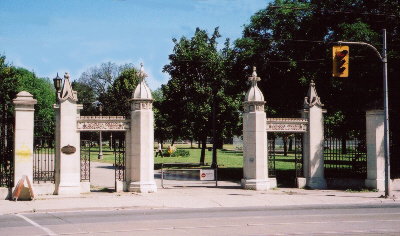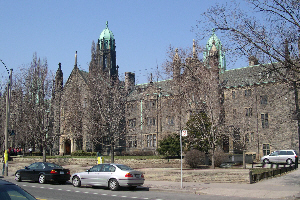Leaders of Upper Canada in the late eighteenth and early nineteenth centuries believed the colony should have an educational network ranging all the way from parochial schools to a provincial university run by the Church of England. John Strachan, later Bishop, was one of these leaders. He had come to Upper Canada, at the age of 21, in 1799 prepared to be a teacher and had established his first school, at Cornwall. He was appointed “officiating minister” at York and chaplain to the garrison in 1812. After the Town of York becoming the City of Toronto in 1834, he was made the first Bishop of Toronto.
After much effort, he was successful in obtaining a Royal university charter from H.M. King George IV in 1827 for King’s College. Unfortunately it was not possible to build a structure, hire staff and open King’s College until 1843. By that time the politics of the colony had changed and the Reform Government ruled that the University of Toronto would be secular. King’s College became the University of Toronto, a secular university, on January 1, 1850. A provincial educational system was established shortly after that.

The Gate at the head of Strachan Avenue is about all that is left of Trinity University on Queen Street West.
The founders of Trinity College, led by John Strachan, did not like this change and so, they founded Trinity University in 1851. (It received the honour of a Royal university charter from H.M. Queen Victoria in August 1852.) A building site was purchased from Janet Cameron in Bellwoods Park on Queen Street West (see Gore Vale) and a Tudor-style building was built of yellow bricks fired on the site. Classes started in January 1852. Trinity functioned as an independent university until 1904, and taught Arts, Divinity, Medicine, Law and Music. It also granted some degrees in Pharmacy and Dentistry. It was a pioneer in women’s higher education in Canada, admitting women from 1884 and adding a whole women’s college, called St. Hilda’s, in 1889.
By 1900, a new era was dawning. The College decided that its desired ends could be more effectively realized by working in federation with the wider University community in Toronto. In 1904, a federation agreement was signed with the University of Toronto, taking effect in 1906. All Trinity University functions under the Charter, except for degree-granting power in Divinity, were ceded to The University of Toronto. Land was purchased in 1913 on Hoskin Avenue, on the University of Toronto campus, and in 1925 the College moved there.

Trinity College on Hoskin Ave.
Though it became part of the University of Toronto, Trinity College retained its distinctive character and many independent features. It now has about 1,500 students in Arts and over 100 in Divinity. A new era began for the college in 1974 when a Memorandum of Understanding was signed with the University, allowing Trinity to expand its academic programme beyond its traditional courses in the humanities. New interdisciplinary programs of study were begun at the College; the first was in International Relations, which has become one of the largest in the University.
The original site of Trinity University was sold to the city, which after using the buildings to house a recreational facility razed them in the late 1950s. This loss inspired the movement for architectural conservation in the city.
For more information about Trinity University, its history and the historic context see the Trinity Website
